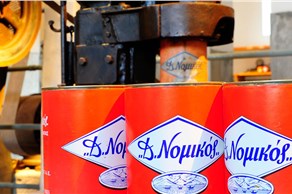The Tomato Industrial Museum of D. Nomikos is housed in an interesting, modern, multi-purpose art space, the Santorini Arts Factory, which is situated along the eye-catching Vlychada Beach, a unique landscape that resembles the moonscape. The cherry tomato is a typical product of Santorini, very famous for its characteristic small size, hard peel, juicy flesh and sweet flavor that makes a great tomato paste, too. Its fine attributes are owned to the arid, yet rich, volcanic soil of Santorini that gives its products a unique taste.
The former prominent tomato processing factory of Dimitrios Nomikos, which not only produced tomato paste but also the cans, used to stand at the place where the current museum lies. His son, George Nomikos, founded the plant in Vlychada, in 1945. Its history was eventful, as it managed to survive a catastrophic flood and the severe earthquake in 1956, and its journey was successful until 1981 when it ceased its operation for good, due to the dramatic reduction of the tomato cultivation in the island of Santorini.
In 2014, about 30 years later, the historical tomato factory was transformed into a modern industrial museum that constitutes a great offering to the society since it gives prominence to the cultural heritage of the island and Greece. Visitors can experience a journey to the past through a guided tour and witness the traditional methods of cultivation, processing and production of tomato. In addition, they can admire the various exhibits that date back to 1890; a collection that includes processing machinery, old tools and manuscript, the first labels ever used, as well as an audiovisual material with recorded narrations of people who worked at the factory that makes the visit worthwhile.
The space right next to the museum is a non-profit organization that serves as a cultural center with the aim to promote culture, education and tradition. Various festivals where people can enjoy plays, concerts and exhibitions take place here, mainly during the summer season. As for education, many workshops and educational programs are organized all year round, where adults and mostly children can enrich their knowledge, become more creative and have fun by participating in various appealing activities. The third goal ‒ promoting the tradition and history of Santorini ‒ is achieved, of course, through the existence of the museum, where people become familiar with the industrial history of the island, its agriculture and gastronomy.
Lastly, the beautiful stone building owns a modern gift shop with lovely souvenirs, clothes, bags, ornaments, handmade ceramics, edibles and publications. All the innovative items are inspired by Greece and are made by Greek creators.
